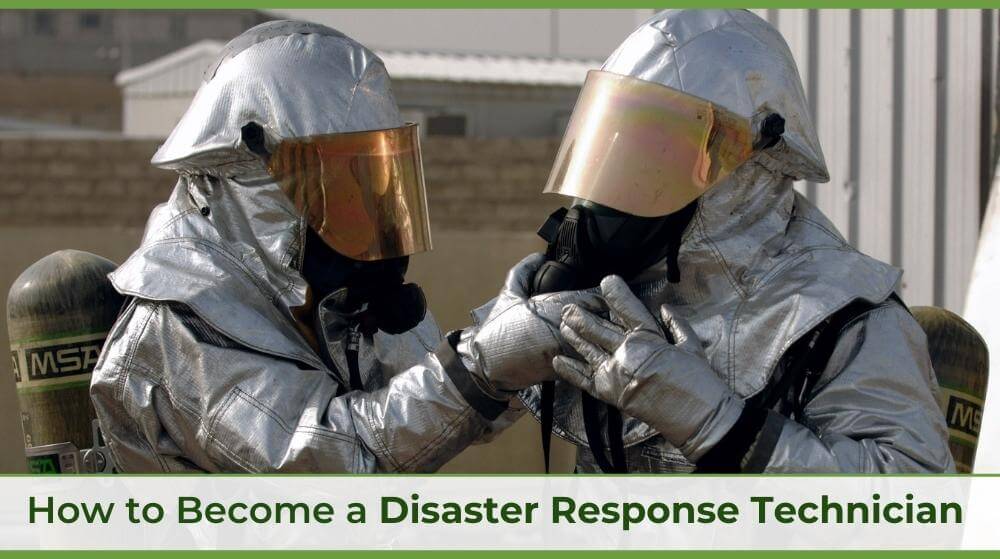
If you like hands-on work and caring for the planet, you may enjoy a job as a disaster response technician. With the effects of climate change worsening, careers in disaster relief will continue to be essential. Are you ready to get your hands dirty?

As a disaster response technician, you can have a direct impact on the environment and begin working without a college degree. This guide covers everything you need to know about how to get into disaster relief work, including junior and senior-level positions.
|
Career Path Overview for Disaster Response Technician |
|
|
Education Requirements |
High School diploma; College Degree for Management Role |
|
Recommended Degree Program |
B.S. in Environmental Health and Safety |
|
Average Salary (2021) |
$46,300 |
|
Workers Employed in U.S. (2021) |
44,700 |
|
Projected Job Openings by 2030 |
-100 |
|
Projected Growth Rate |
0% (little to no change) |
|
Other Job Titles |
Hazardous materials removal worker |
|
Related Careers |
|
Source: Bureau of Labor Statistics (BLS)
What Does a Disaster Response Technician Do?
Disaster response technicians work on the sites of various events, such as oil spills and trucking accidents. They clean up toxic materials to protect the public and the environment. This includes handling heavy objects, chemicals, and hazardous waste. This can be a dangerous and physically-demanding job. Proper protective wear such as hazmat suits, gloves, and goggles is necessary. Disaster response technicians take other safety precautions in the field based on government policies and regulations.
Disaster response technicians also work in natural disaster clean-up jobs. They help clean up communities and natural areas after disasters such as hurricanes, flooding, and wildfires. Storm cleanup jobs may include setting up temporary shelters for those affected by the disaster and aiding with rebuilding projects.
Junior Disaster Response Technician Job Description
Junior disaster response technicians should expect to spend a lot of time in the field doing strenuous labor such as loading and unloading heavy equipment or operating machinery at emergency sites. Strong communication skills are also necessary. As a technician in the field, you may interact with the public frequently to answer questions and provide information that helps ensure everyone’s safety. Other duties and responsibilities include:
- Accurate project documentation and compliance
- Clear communication with team members and supervisors
- Knowledge of local, state, and federal government regulations
- Ability to stay calm in stressful situations
Advanced Disaster Response Technician Job Description
A full-time senior-level emergency response worker may be a manager, coordinator, or director. These positions involve less time working in the field and more time in offices and traveling to different sites. A leadership position in disaster response may require:
- Training and supervising technicians across sites
- Planning and implementing emergency responses and preventative efforts
- Reviewing projects for regulation and compliance
- Attending and leading meetings with various stakeholders

Where Do Disaster Response Technicians Work?
Many emergency response technician jobs are for the government at the local, state, or federal level. Other technicians work for nonprofit organizations or private companies that assist in disaster response efforts. These often include construction companies and waste management services. Some public and private sector jobs are temporary positions during active emergencies or clean-up projects. Traveling disaster relief jobs allow you to go where your help is most needed.
Average Disaster Response Technician Salary
The median annual pay for hazardous waste removal workers in 2021 was $46,300. However, earning potential varies based on the state. Disaster relief workers in Alaska earn $68,630 a year on average. Workers in New York, North Dakota, Minnesota, and Washington also earn over $60,000 a year on average. Upper-level positions like emergency management directors earn more, with a median annual salary of $87,440.
|
Top 5 States for Geoscientist Salary in U.S. |
||
|
State |
Average Annual Salary |
Average Hourly Rate |
|
$68,630 |
$33.00 |
|
|
$63,410 |
$30.49 |
|
|
$61,610 |
$29.62 |
|
|
$61,090 |
$29.37 |
|
|
$60,790 |
$29.23 |
|
Source: Bureau of Labor Statistics
What is the Job Outlook for Disaster Response Technicians?
There is expected to be little to no change in the number of hazardous waste removal jobs in the next decade. However, more extreme weather and natural disasters due to global warming may increase the amount of storm cleanup jobs more than predicted. When we look specifically at BLS data on careers in disaster relief, the job outlook shows a faster-than-average increase in open positions through 2026.
- Estimate of Jobs available: 44,700
- Rate of projected job growth: 0%
- New jobs to be added in the next 10 years: 0-100
- States with a high concentration of disaster clean-up jobs: Alaska, Hawaii, and Colorado

Disaster Response Technician Education Recommendations
For high school students who want to start working right after graduation, emergency relief technician may be a good fit for you. Entry-level disaster response jobs do not require a college degree. Many positions provide extensive on-the-job training to help technicians work towards getting their OSHA certification which requires 40 hours of instruction.
If your goal is to advance in a disaster relief career, consider pursuing a degree in environmental science to increase your promotion opportunities. You can work as a junior technician to help pay for school. Supervisor positions often require a bachelor’s degree or higher.
Disaster Response Technician High School Recommendations
Disaster response technician education starts in high school. If your high school offers an environmental studies class, take it. Other advanced science classes such as chemistry and biology are beneficial for an aspiring emergency response worker.
Participating in extracurricular activities in high school can also provide experience to prepare you for emergency disaster services jobs. Examples include:
- First aid and CPR certification
- Youth cadet program
- Volunteer beach clean-up
Disaster Response Technician College Education Recommendations
While many technician positions only require a high school diploma, some require an associate degree. Associate degrees usually take two years to complete.
High-paying disaster relief jobs such as Environmental Emergency Planner and Emergency Management Director often require a bachelor’s or master’s degree. This can take four to six years to complete depending on the program.
Undergraduate
A bachelor’s degree, such as a B.S. in Environmental Health and Safety, can prepare you for many senior-level emergency disaster jobs. If you are interested in promoting sustainable business practices to prevent environmental disasters in the first place, consider a degree in Sustainable Business Management.
Postgraduate
Earning a master’s degree after undergraduate school can increase your earning potential and open up more opportunities. This is a great option for technicians looking to get out of the field and into an office or lab.
Additional Certifications and Licenses
A disaster response technician’s daily responsibilities vary greatly depending on the employer and the project they are currently working on. Different employers may require different certifications. Additional certifications and training that could be beneficial for disaster relief workers include:
- CPR
- Search and Rescue (SAR)
- EMT
- Geographic Information Systems (GIS)
Learn how environmental scientists use GIS to predict and prevent disasters from Unity’s blog.
Recommended Unity Environmental University Degrees and Courses
B.S. in Environmental Studies
Students in the environmental science program build knowledge and skills related to natural resources and human behavior through classroom and field experiences. This will prepare them for natural disaster clean-up jobs as well as a variety of other environmental crisis relief jobs such as being a firefighter or an environmental data analyst.
Explore More Career Paths Related to Disaster Response Technicians
Environmental Emergency Planner
Environmental emergency planners create plans and procedures in case of emergencies including natural disasters. If you like thinking ahead and solving complex problems, this may be the right career for you.
Disaster Program Manager
Disaster program managers lead teams of workers and volunteers during emergency responses and cleanups. They may manage multiple sites and travel between them or manage teams from multiple organizations working on a project together.



